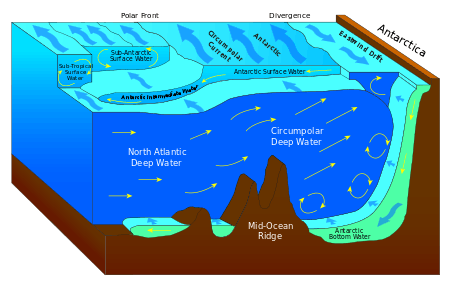Eddy (fluid dynamics)
In fluid dynamics, an eddy is the swirling of a fluid and the reverse current created when the fluid is in a turbulent flow regime.[2] The moving fluid creates a space devoid of downstream-flowing fluid on the downstream side of the object. Fluid behind the obstacle flows into the void creating a swirl of fluid on each edge of the obstacle, followed by a short reverse flow of fluid behind the obstacle flowing upstream, toward the back of the obstacle. This phenomenon is naturally observed behind large emergent rocks in swift-flowing rivers.
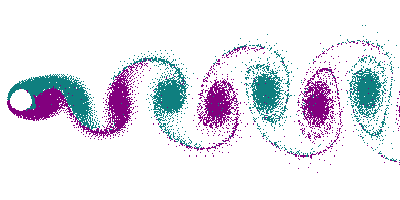
Swirl and eddies in engineering
The propensity of a fluid to swirl is used to promote good fuel/air mixing in internal combustion engines.
In fluid mechanics and transport phenomena, an eddy is not a property of the fluid, but a violent swirling motion caused by the position and direction of turbulent flow.[3]

Reynolds number and turbulence

In 1883, scientist Osborne Reynolds conducted a fluid dynamics experiment involving water and dye, where he adjusted the velocities of the fluids and observed the transition from laminar to turbulent flow, characterized by the formation of eddies and vortices.[4] Turbulent flow is defined as the flow in which the system's inertial forces are dominant over the viscous forces. This phenomenon is described by Reynolds number, a unit-less number used to determine when turbulent flow will occur. Conceptually, the Reynolds number is the ratio between inertial forces and viscous forces.[5]
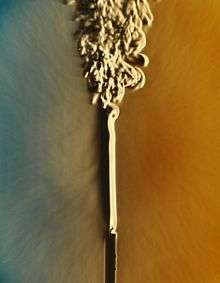
The general form for the Reynolds number flowing through a tube of radius r (or diameter d):
where v is the velocity of the fluid, ρ is its density, r is the radius of the tube, and μ is the viscosity of the fluid. to turbulent flow in a fluid is defined by the critical Reynolds number, for a closed pipe this works out to approximately
In terms of the critical Reynolds number, the critical velocity is represented as
Research and development
Computational fluid dynamics
These are turbulence models in which the Reynolds stresses, as obtained from a Reynolds averaging of the Navier–Stokes equations, are modelled by a linear constitutive relationship with the mean flow straining field, as:
where
- is the coefficient termed turbulence "viscosity" (also called the eddy viscosity)
- is the mean turbulent kinetic energy
- is the mean strain rate
- Note that that inclusion of in the linear constitutive relation is required by tensorial algebra purposes when solving for two-equation turbulence models (or any other turbulence model that solves a transport equation for .[6]
Hemodynamics
Hemodynamics is the study of blood flow in the circulatory system. Blood flow in straight sections of the arterial tree are typically laminar (high, directed wall stress), but branches and curvatures in the system cause turbulent flow.[2] Turbulent flow in the arterial tree can cause a number of concerning effects, including atherosclerotic lesions, postsurgical neointimal hyperplasia, in-stent restenosis, vein bypass graft failure, transplant vasculopathy, and aortic valve calcification.
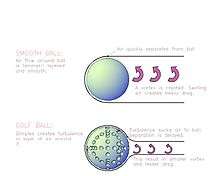
Industrial processes
Lift and drag properties of golf balls are customized by the manipulation of dimples along the surface of the ball, allowing for the golf ball to travel further and faster in the air.[7][8] The data from turbulent-flow phenomena has been used to model different transitions in fluid flow regimes, which are used to thoroughly mix fluids and increase reaction rates within industrial processes.[9]
Fluid currents and pollution control
Oceanic and atmospheric currents transfer particles, debris, and organisms all across the globe. While the transport of organisms, such as phytoplankton, are essential for the preservation of ecosystems, oil and other pollutants are also mixed in the current flow and can carry pollution far from its origin.[10][11] Eddy formations circulate trash and other pollutants into concentrated areas which researchers are tracking to improve clean-up and pollution prevention. The distribution and motion of plastics caused by eddy formations in natural water bodies can be predicted using Lagrangian transport models.[12] Mesoscale ocean eddies play crucial roles in transferring heat poleward, as well as maintaining heat gradients at different depths.[13]
Environmental flows
Modeling eddy development, as it relates to turbulence and fate transport phenomena, is vital in grasping an understanding of environmental systems. By understanding the transport of both particulate and dissolved solids in environmental flows, scientists and engineers will be able to efficiently formulate remediation strategies for pollution events. Eddy formations play a vital role in the fate and transport of solutes and particles in environmental flows such as in rivers, lakes, oceans, and the atmosphere. Upwelling in stratified coastal estuaries warrant the formation of dynamic eddies which distribute nutrients out from beneath the boundary layer to form plumes.[14] Shallow waters, such as those along the coast, play a complex role in the transport of nutrients and pollutants due to the proximity of the upper-boundary driven by the wind and the lower-boundary near the bottom of the water body.[15]
Mesoscale ocean eddies
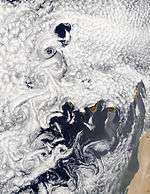
Eddies are common in the ocean, and range in diameter from centimeters to hundreds of kilometers. The smallest scale eddies may last for a matter of seconds, while the larger features may persist for months to years.
Eddies that are between about 10 and 500 km (6.2 and 310.7 miles) in diameter and persist for periods of days to months are known in oceanography as mesoscale eddies.[16]
Mesoscale eddies can be split into two categories: static eddies, caused by flow around an obstacle (see animation), and transient eddies, caused by baroclinic instability.
When the ocean contains a sea surface height gradient this creates a jet or current, such as the Antarctic Circumpolar Current. This current as part of a baroclinically unstable system meanders and creates eddies (in much the same way as a meandering river forms an ox-bow lake). These types of mesoscale eddies have been observed in many of major ocean currents, including the Gulf Stream, the Agulhas Current, the Kuroshio Current, and the Antarctic Circumpolar Current, amongst others.
Mesoscale ocean eddies are characterized by currents that flow in a roughly circular motion around the center of the eddy. The sense of rotation of these currents may either be cyclonic or anticyclonic (such as Haida Eddies). Oceanic eddies are also usually made of water masses that are different from those outside the eddy. That is, the water within an eddy usually has different temperature and salinity characteristics to the water outside the eddy. There is a direct link between the water mass properties of an eddy and its rotation. Warm eddies rotate anti-cyclonically, while cold eddies rotate cyclonically.
Because eddies may have a vigorous circulation associated with them, they are of concern to naval and commercial operations at sea. Further, because eddies transport anomalously warm or cold water as they move, they have an important influence on heat transport in certain parts of the ocean.
See also
- Eddy diffusion
- Haida Eddies
- Reynolds number - a dimensionless constant used to predict the onset of turbulent flow
- Reynolds experiment
- Kármán vortex street
- Whirlpool
- Whirlwind
- River Eddies in Whitewater
- Wake turbulence
- Computational Fluid Dynamics
- Laminar flow
- Hemodynamics
- Modons, or dipole eddy pairs.
References
- Tansley, Claire E.; Marshall, David P. (2001). "Flow past a Cylinder on a Plane, with Application to Gulf Stream Separation and the Antarctic Circumpolar Current" (PDF). Journal of Physical Oceanography. 31 (11): 3274–3283. Bibcode:2001JPO....31.3274T. doi:10.1175/1520-0485(2001)031<3274:FPACOA>2.0.CO;2. Archived from the original (PDF) on 2011-04-01.
- Chiu, Jeng-Jiann; Chien, Shu (2011-01-01). "Effects of Disturbed Flow on Vascular Endothelium: Pathophysiological Basis and Clinical Perspectives". Physiological Reviews. 91 (1): 327–387. doi:10.1152/physrev.00047.2009. ISSN 0031-9333. PMC 3844671. PMID 21248169.
- Lightfoot, R. Byron Bird ; Warren E. Stewart ; Edwin N. (2002). Transport phenomena (2. ed.). New York, NY [u.a.]: Wiley. ISBN 0-471-41077-2.
- Kambe, Tsutomu (2007). Elementary Fluid Mechanics. World Scientific Publishing Co. Pte. Ltd. pp. 240. ISBN 978-981-256-416-0.
- "Pressure". hyperphysics.phy-astr.gsu.edu. Retrieved 2017-02-12.
- "Linear eddy viscosity models -- CFD-Wiki, the free CFD reference". www.cfd-online.com. Retrieved 2017-02-12.
- Arnold, Douglas. "The Flight of a Golf Ball" (PDF).
- "Why are Golf Balls Dimpled?". math.ucr.edu. Retrieved 2017-02-12.
- Dimotakis, Paul. "The Mixing Transition in Turbulent Flows" (PDF). California Institute of Technology Information Tech Services.
- "Ocean currents push phytoplankton, and pollution, around the globe faster than thought". Science Daily. 16 April 2016. Retrieved 2017-02-12.
- "Ocean Pollution". National Oceanic and Atmospheric Administration.
- Daily, Juliette; Hoffman, Matthew J. (2020-05-01). "Modeling the three-dimensional transport and distribution of multiple microplastic polymer types in Lake Erie". Marine Pollution Bulletin. 154: 111024. doi:10.1016/j.marpolbul.2020.111024. ISSN 0025-326X. PMID 32319887.
- "Ocean Mesoscale Eddies – Geophysical Fluid Dynamics Laboratory". www.gfdl.noaa.gov. Retrieved 2017-02-12.
- Chen, Zhaoyun; Jiang, Yuwu; Wang, Jia; Gong, Wenping (2019-07-23). "Influence of a River Plume on Coastal Upwelling Dynamics: Importance of Stratification". Journal of Physical Oceanography. 49 (9): 2345–2363. doi:10.1175/JPO-D-18-0215.1. ISSN 0022-3670.
- Roman, F.; Stipcich, G.; Armenio, V.; Inghilesi, R.; Corsini, S. (2010-06-01). "Large eddy simulation of mixing in coastal areas". International Journal of Heat and Fluid Flow. Sixth International Symposium on Turbulence and Shear Flow Phenomena. 31 (3): 327–341. doi:10.1016/j.ijheatfluidflow.2010.02.006. ISSN 0142-727X.
- Tansley, Claire E.; Marshall, David P. (2001). "Flow past a Cylinder on a β Plane, with Application to Gulf Stream Separation and the Antarctic Circumpolar Current". Journal of Physical Oceanography. 31 (11): 3274–3283. Bibcode:2001JPO....31.3274T. doi:10.1175/1520-0485(2001)031<3274:FPACOA>2.0.CO;2. ISSN 1520-0485. S2CID 130455873.

